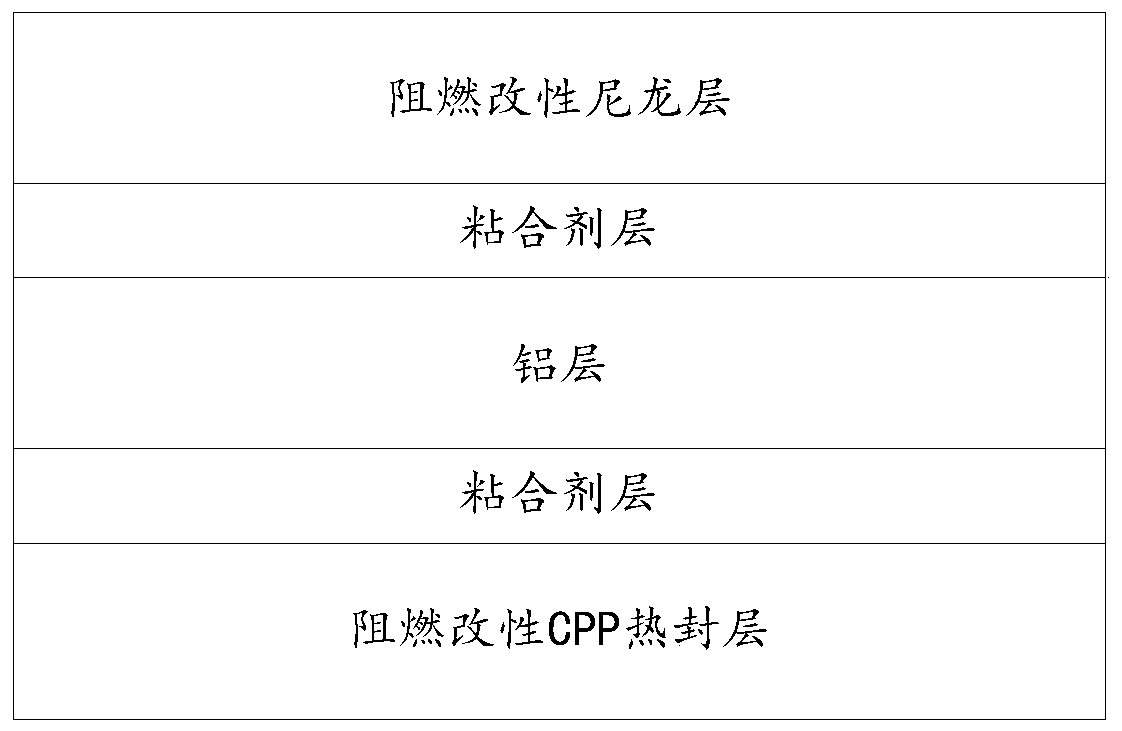Antiflaming aluminum plastic film and preparation method thereof
A technology of aluminum-plastic film and flame retardant, which is applied in the field of aluminum-plastic film, can solve the problem of reducing the strength of the bonding layer, the mechanical properties of the aluminum-plastic film, the incompatibility of the flame retardant and the material of the bonding layer, and affecting the aluminum-plastic film. interlayer bond strength etc.
- Summary
- Abstract
- Description
- Claims
- Application Information
AI Technical Summary
Problems solved by technology
Method used
Image
Examples
preparation example Construction
[0045] A method for preparing a flame-retardant aluminum-plastic film, the method comprising:
[0046] Preparation of flame retardant modified nylon layer:
[0047] Add 0.5-2 parts by mass of reactive flame retardant, 0.1-0.5 parts by mass of absolute ethanol and 0.5-2 parts by mass of deionized water into a three-necked flask, stir fully in an oil bath environment at 60-100°C, and slowly drop Add 0.01-0.05 parts by mass of hexamethylenediamine-ethanol solution, and react at a constant temperature for 2-4 hours; after the reaction, filter the reaction product with suction, and vacuum-dry the obtained solid product at 60-80°C for 12-24 hours to obtain a flame retardant salt ,spare;
[0048] Mix 0.3-2.3 parts by mass of flame retardant salt with 4.2-7.7 parts by mass of nylon salt, add 0.4-1.7 parts by mass of deionized water to the mixed salt, and adjust its pH value to 7.5-8; add 0.05-0.5 parts by mass of sodium hypophosphite to the mixed solution as a catalyst, mix well and...
Embodiment 1
[0058] 1. Preparation of surface flame retardant modified nylon layer
[0059] 1.1 Synthesis of flame retardant salt
[0060] Add 0.05 parts by mass of reactive flame retardant 2,2-bis((4-phenoxyphenylphosphine oxide)-p-aminobenzoic acid) propane (BPOAP), 0.13 parts by mass of absolute ethanol and 1 mass part 0.05 parts by mass of hexamethylenediamine-ethanol solution (hexamethylenediamine volume concentration: 5%) was slowly dropped into the above solution, and reacted at constant temperature for 2 hours. After the reaction, the reaction product was filtered with suction, and the obtained solid product was vacuum-dried at 80° C. for 12 hours for future use.
[0061] 1.2 Synthesis of flame retardant modified nylon layer
[0062] 1.2.1 Weigh 1 part by mass of the flame retardant BPOAP salt prepared in step 1 and mix it with 6.8 parts by mass of nylon 66 salt (intermediate product of nylon 66 synthesis, non-polymeric state), and add 1.2 parts by mass of Deionized water, and a...
Embodiment 2
[0079] The difference from Example 1 is that the composition of the flame-retardant modified CPP layer is different, and the mass and number ratio of PP, intumescent flame retardant (PEPA:MPP=11:9 (wt%)) and compatibilizer in step 2.1 Be 10:3:0.05, all the other parameters are identical with embodiment 1.
PUM
| Property | Measurement | Unit |
|---|---|---|
| Thickness | aaaaa | aaaaa |
| Thickness | aaaaa | aaaaa |
Abstract
Description
Claims
Application Information
 Login to View More
Login to View More - R&D Engineer
- R&D Manager
- IP Professional
- Industry Leading Data Capabilities
- Powerful AI technology
- Patent DNA Extraction
Browse by: Latest US Patents, China's latest patents, Technical Efficacy Thesaurus, Application Domain, Technology Topic, Popular Technical Reports.
© 2024 PatSnap. All rights reserved.Legal|Privacy policy|Modern Slavery Act Transparency Statement|Sitemap|About US| Contact US: help@patsnap.com










